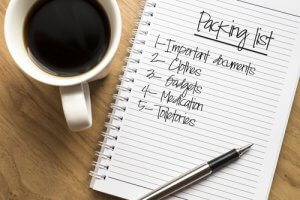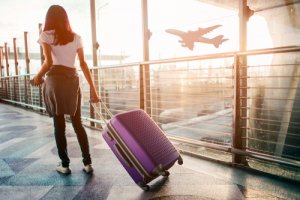What to Bring to Rehab: A Rehab Packing List Guide
Plans are in place. You’re on your way to recovery by opting for residential treatment to help get you there. There’s so much going through your head as you embark on this journey. So let’s lessen the load by addressing one aspect.
What do you bring with you to rehab? The short answer is as little as possible. Yet, there are essentials to pack. Conversely, there are items to leave behind. Sometimes, the facility provides a guide to both ends. But at all times, the approach is: less is best. That said, you will be living at the recovery center. So you’ll need the fundamentals.
What to Pack for Rehab
Packing for rehab is an important step in preparing for your stay, whether it’s for substance abuse, mental health treatment, or both. The specific items you’ll need may vary depending on the rehab facility’s policies and the nature of your treatment, but there is a general list of items you should consider consider packing which will be outlined below.
Documents to Bring to Rehab
There are some documents for identification which rehab facilities will often require you to bring:
- Identification (driver’s license, passport, or ID card).
- Insurance information.
- Any necessary medical records or prescriptions.
Personal Hygiene Products
Common items include:
- Toothbrush.
- Toothpaste.
- Mouthwash.
- Comb/brush.
- Shampoo.
- Deodorant.
- Soap.
- Feminine hygiene products.
- Shaving cream.
Toiletries should be sealed and unopened. Bring enough to last 30 days. Check the ingredients to ensure nothing contains alcohol, such as mouthwash. It’s also wise to have an extra pair of eyeglasses with you and, ideally, a copy of your prescription. 
Questions to ask: Do you need your own pillow, towels, linens, blanket? Can you bring a hairdryer? What are the guidelines about bringing disposable or electric razors for shaving?
Clothing
Common clothing items to pack should be the daily essentials, such as:
- Pajamas.
- Robe.
- Shower shoes.
- Undergarments.
- Socks, pants/shorts.
- Shirts/blouses.
- Shoes.
Casual and comfortable is the motif. For recreation/fitness, you should bring:
- Gym shorts.
- Tee shirts.
- Sweats.
- Sneakers.
- Swimwear.
- Walking/hiking shoes.
For the outdoors, depending on the climate, add sweater/sweatshirt, jacket, rain gear, head covering and sunscreen.
How much should you bring? Typically, there are laundry facilities onsite or arrangements to do wash locally. For that reason, all you need is enough for 7-10 days, e.g., several tops and bottoms. Stick to the minimum because of space and storage constraints.
Questions to ask: Is there a dress code? What weather conditions can you expect and are there special items to take for that climate? Do you need a more formal outfit for religious services or special occasions? Are laundry machines coin operated? If so, bring rolls of coins and small bills for change machines. Do you need to bring laundry detergent?
Medication
Take your prescription medication in unopened original containers, clearly labeled with dosage instructions. The facility typically stores these meds for you and administers them. Make a list of these items with prescribers’ and pharmacy names, Rx numbers and dosage information as a backup. A week before leaving, ensure you have a new 30-day supply and refills for all of your meds.
Questions to ask: Are specific OTC medications acceptable, including vitamins? Ask about them by name and dosage to determine if they are allowed. If so, bring them in new, unopened containers with original labels.
Money
For spending money, bring $50-100. Also take a credit/debit card, official identification (e.g., driver’s license) and your insurance card(s). Make a list of these with the important information on them as a backup.
Questions to ask: Do you need a checkbook/checks? Will monetary items be stored in safekeeping for you along with your other important documents?
Electronics
Recovery centers have their own set of guidelines about what you can take with you and when they can be used. Devices in this category include cellphone, laptop, tablet, e-book reader/Kindle, music player/iPod.
Questions to ask: Inquire about all of the above along with policies for using them to determine if and what you want to bring.
Miscellaneous
This category includes reading materials, notebook, pens, letter writing paper and envelopes along with postage, list of contacts with addresses and telephone numbers. Bring photos of your loved ones. Consider adding a telephone calling card in case no cellphones are allowed or reception is poor.
Questions to ask: What are guidelines for smoking and e-cigarettes/vaping? Generally you can bring traditional cigarettes in unopened packs or cartons,
What You Should Not Bring to Rehab
It is advised to contact the treatment center before in order to verify which items are prohibited and which are not, as explained earlier in this article. Every facility has different policies, and some may prohibit an item where others may not. Some items may also not be prohibited but are not required to pack as the rehab center will often provide them to you, such as an alarm clock. Generally, items which are not advised to bring include:
- Alcohol/illicit drugs.
- Cigarettes and e-cigarettes.
- Weapons (such as knives).
- Sharp objects (such as scissors).
- Toiletries that contain alcohol (such as mouthwash).
- Aerosols.
- Prescription medication that does not belong to you or is not in the original container.
- Nail polish and nail polish remover.
- Video games.
- Candles and incense.
- Inappropriate clothing (such as clothing that may reference drugs or alcohol, use profanity etc.)
Information from two American Addiction Centers facilities serves as a guide here:
- Greenhouse Treatment Center, Dallas, notes: “We ask that you do not bring any of the following items: outside food or drink, suggestive clothing, illicit drugs or alcohol.”
- Laguna Treatment Center in Orange County in California, repeats this information and adds: “For your safety, please do NOT bring your own vape, as we don’t know what substances might be in the vape and it may impact your treatment course. Vape juice is available for purchase and the facility.”

Preparing to Leave for Rehab
Make arrangements for your mail to be temporarily held at the post office or picked up by someone during your time in treatment. With all of the things going on, be sure to have pets cared for in your absence. It also would be advisable for someone to have access to your home to check on it while you are away. Knowing how to prepare for this meaningful step in your life should help set your mind at ease and enhance your comfort level.

